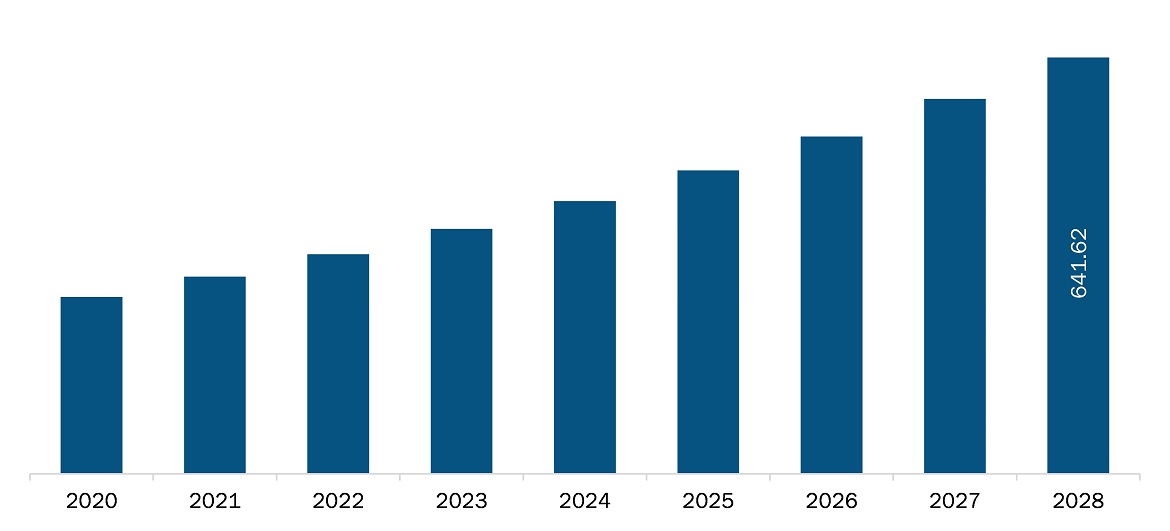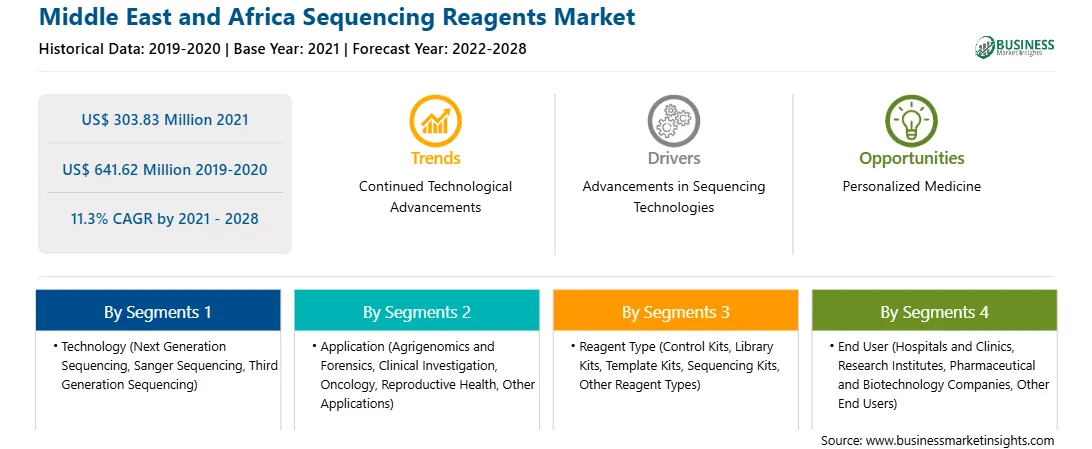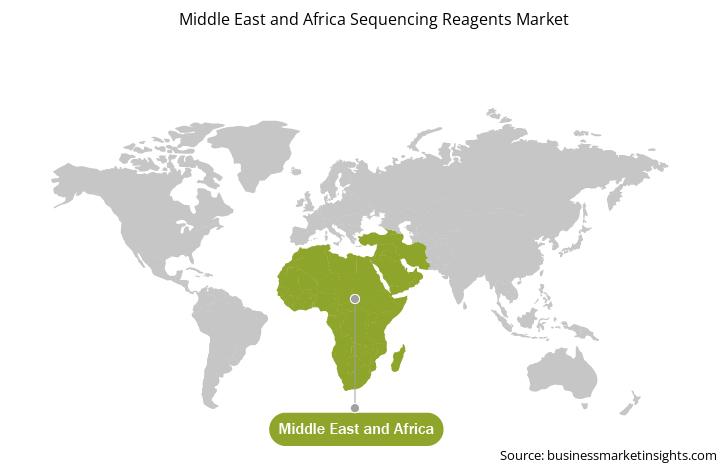Sequencing reagents are used during the process of sequencing. The use of these reagents highly depends on the desired result to be obtained. They form an essential part of the sequencing reactions, which can be used across various other applications as well.

Strategic insights for the Middle East and Africa Sequencing Reagents provides data-driven analysis of the industry landscape, including current trends, key players, and regional nuances. These insights offer actionable recommendations, enabling readers to differentiate themselves from competitors by identifying untapped segments or developing unique value propositions. Leveraging data analytics, these insights help industry players anticipate the market shifts, whether investors, manufacturers, or other stakeholders. A future-oriented perspective is essential, helping stakeholders anticipate market shifts and position themselves for long-term success in this dynamic region. Ultimately, effective strategic insights empower readers to make informed decisions that drive profitability and achieve their business objectives within the market.

| Report Attribute | Details |
|---|---|
| Market size in 2021 | US$ 303.83 Million |
| Market Size by 2028 | US$ 641.62 Million |
| Global CAGR (2021 - 2028) | 11.3% |
| Historical Data | 2019-2020 |
| Forecast period | 2022-2028 |
| Segments Covered |
By Technology
|
| Regions and Countries Covered | Middle East and Africa
|
| Market leaders and key company profiles |
The geographic scope of the Middle East and Africa Sequencing Reagents refers to the specific areas in which a business operates and competes. Understanding local distinctions, such as diverse consumer preferences (e.g., demand for specific plug types or battery backup durations), varying economic conditions, and regulatory environments, is crucial for tailoring strategies to specific markets. Businesses can expand their reach by identifying underserved areas or adapting their offerings to meet local demands. A clear market focus allows for more effective resource allocation, targeted marketing campaigns, and better positioning against local competitors, ultimately driving growth in those targeted areas.

The Middle East and Africa sequencing reagents market is expected to reach US$ 641.62 million by 2028 from US$ 303.83 million in 2021; it is estimated to grow at a CAGR of 11.3% from 2021 to 2028. The growth of the market is attributed to some key driving factors such as increasing demand for third generation sequencing and personalized medicines is expected to boost the sequencing reagents market. However, dearth of skilled professionals is expected to obstruct the growth of the market to a certain extent during the forecast years.
Genomic sequencing technologies have revolutionized mutation detection of the genetic diseases in the past few years. In recent years, the third-generation sequencing (TGS) has been gaining insight into more genetic diseases, owing to the single molecular and real time sequencing technology. One of these new technologies was developed by Pacific Biosciences and is called Single-Molecule Sequencing in Real Time (SMRT). SMRT is very efficient, which means that fewer expensive chemicals must be used. It is also incredibly sensitive, enabling scientists to effectively ‘eavesdrop’ on DNA polymerase and observe it making a strand of DNA. A rise in the demand for third-generation sequencing (TGS) technologies is attributive to the lucrative growth rate of this segment. With the emergence of TGS, genome sequencing has become a faster and reliable method to study genomic variations. Also, personalized medicine offers the most promising approaches to tackle diseases, which have far eluded effective treatments or cures. Increasing adoption of personalized medicines for disease treatments using the patient’s genetic information is expected to aid in offering targeted treatment. This, in turn, is expected to create lucrative growth opportunities for the sequencing reagent market soon.
The COVID-19 pandemic has become the most significant challenge in the Middle East region. This challenge would be particularly frightening for the region's fragile and conflict-torn states, such as Iraq and Israel, because it will result in reduced imports due to global trade disruptions, which will exacerbate shortages of medical supplies and other goods, resulting in significant price rise. However, the sequencing reagents market in this pandemic is on rising as increasing use of sequencing reagents in the clinical studies of COVID-19. Diagnostic and treatments of COVID-19 needs a huge the clinical study for which sequencing reagents are important thus the demand of the reagents is increasing. These factors had a potential impact on the Middle East and Africa sequencing reagents market.
The Middle East and Africa sequencing reagents market, by technology, is segmented into next generation sequencing, sanger sequencing, and third generation sequencing. The next generation sequencing segment held the largest share of the market in 2020. However, the sanger sequencing segment is anticipated to register the highest CAGR in the market during the forecast period.
The Middle East and Africa sequencing reagents market, by reagent type, is segmented into control kits, library kits, template kits, sequencing kits, and other reagent types. The sequencing kits held the largest share of the market in 2020. However, the library kits segment is anticipated to register the CAGR in the market during the forecast period.
The Middle East and Africa sequencing reagents market, by application, is segmented into agrigenomics and forensics, clinical investigation, oncology, reproductive health, and other applications. The oncology segment held the largest share of the market in 2020. However, the clinical investigation segment is anticipated to register the highest CAGR in the market during the forecast period.
Based on end user, the Middle East and Africa sequencing reagents market is segmented into hospitals and clinics, research institutes, and pharmaceutical and biotechnology companies, and other end users. The research institutes segment held the largest share of the market in 2020. Also, the same segment is estimated to register the highest CAGR in the market during the forecast period.
A few of the primary and secondary sources associated with this report on the Middle East and Africa sequencing reagents market are the King Faisal Specialist Hospital & Research Center (KFSHRC), KwaZulu-Natal Research Innovation and Sequencing Platform (KRISP) and Emirates Scientists Council (ESC).
The Middle East and Africa Sequencing Reagents Market is valued at US$ 303.83 Million in 2021, it is projected to reach US$ 641.62 Million by 2028.
As per our report Middle East and Africa Sequencing Reagents Market, the market size is valued at US$ 303.83 Million in 2021, projecting it to reach US$ 641.62 Million by 2028. This translates to a CAGR of approximately 11.3% during the forecast period.
The Middle East and Africa Sequencing Reagents Market report typically cover these key segments-
The historic period, base year, and forecast period can vary slightly depending on the specific market research report. However, for the Middle East and Africa Sequencing Reagents Market report:
The Middle East and Africa Sequencing Reagents Market is populated by several key players, each contributing to its growth and innovation. Some of the major players include:
The Middle East and Africa Sequencing Reagents Market report is valuable for diverse stakeholders, including:
Essentially, anyone involved in or considering involvement in the Middle East and Africa Sequencing Reagents Market value chain can benefit from the information contained in a comprehensive market report.